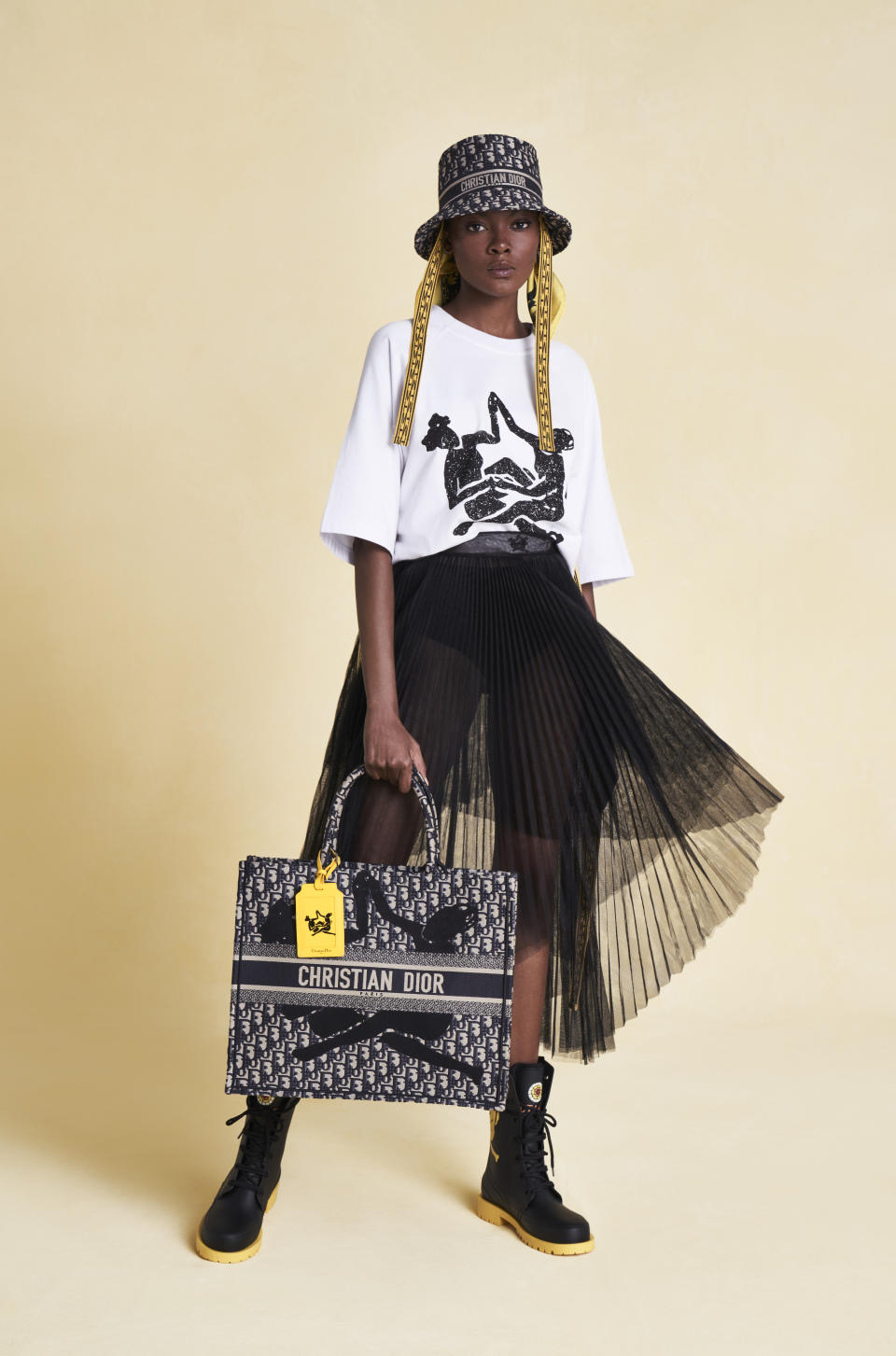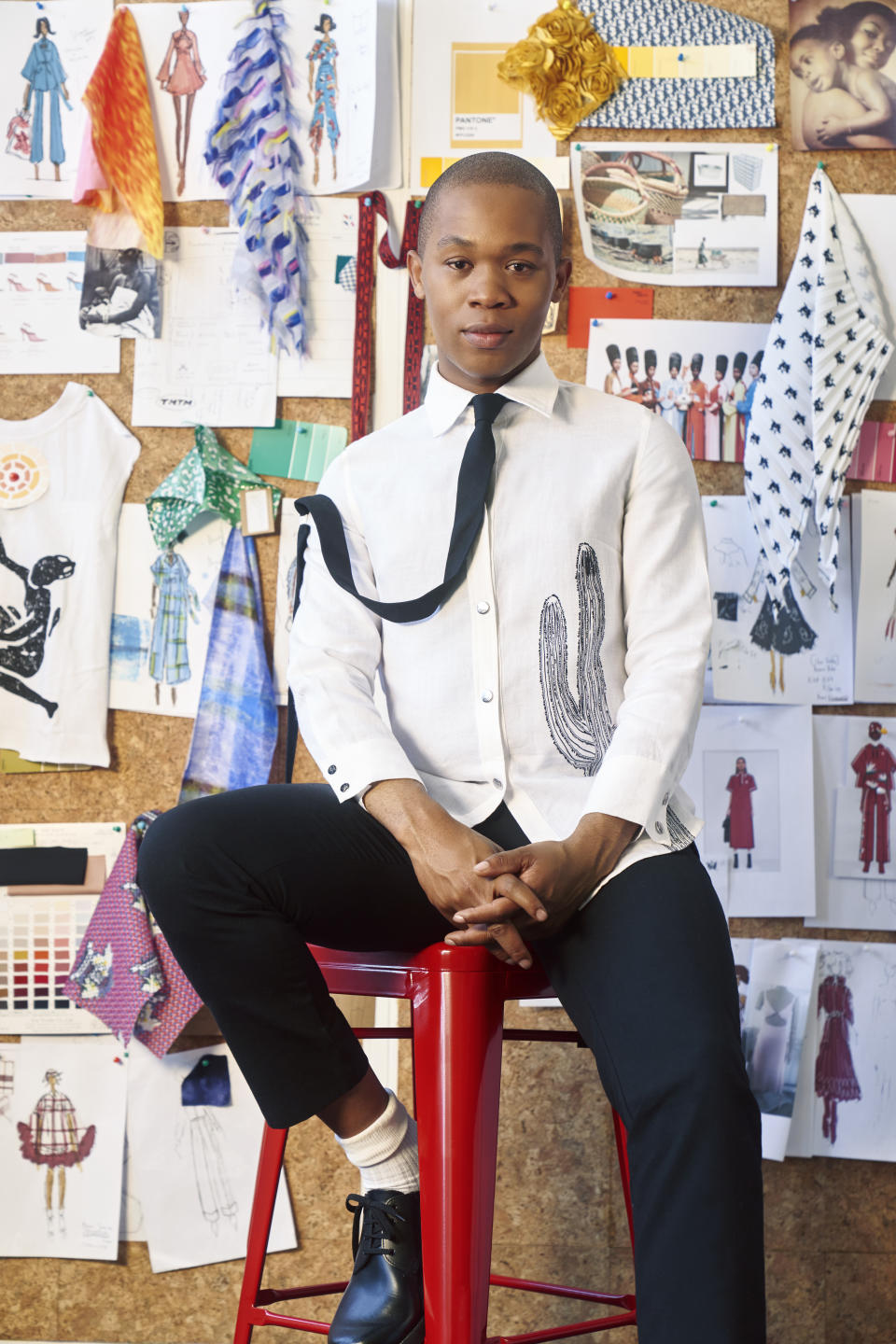EXCLUSIVE: Dior Teams With Thebe Magugu for Charity Project

When Thebe Magugu was a fashion student in Johannesburg, little did he know that a second-year assignment would turn out to be a dress rehearsal for one of the most high-profile — and purposeful — collaborations of his career so far.
Students at the LISOF fashion school were tasked to interpret Christian Dior’s New Look, the pinch-waisted, fan-skirted look that caused a sensation in 1947. Magugu made his jacket in red, with “very small, rounded shoulders” and many darts, and the skirt a swirling, full-circle style.
More from WWD
Fast-forward and Magugu, now 29, was tasked by Dior’s Maria Grazia Chiuri to reinterpret anew the New Look, all in aid of the Charlize Theron Africa Outreach Project, a charity that aids South African youth.
“It’s like I completed my homework eight years ago,” he said with a chuckle.
The limited-edition capsule collection drops on Oct. 27 at Dior’s flagship boutiques in Paris, France; New York, and Los Angeles, California. In tandem, Dior has made a lump-sum donation to the CTAOP, established in 2007 by Theron, a brand ambassador and the longtime face of J’Adore perfume.
To be sure, Dior’s fashion legacy has reverberated all the way down to the bottom of the African continent.
“I’m from a small mining town called Kimberly, a place which sometimes is completely overlooked on certain maps. But even there people are very familiar with Christian Dior,” Magugu said in an interview. “It sort of revolutionized how women dress.”
Magugu reimagined the New Look’s hallmark cinched jacket as a cotton T-shirt, with straps emerging from the inseams that allow the wearer to highlight the waist to varying degrees.
He explained that the T-shirt is a “universally understood item,” here fronted with a graphic depicting two females holding hands. This “powerful symbol of sisterhood” is a key brand emblem at Magagu’s signature label, and a reflection of the feminist theme Chiuri has woven into her tenure as Dior’s artistic director of women’s haute couture, ready-to-wear and accessory collections.
The flaring skirt, meanwhile, is “a beautiful pairing between my universe and Maria’s universe,” he said. “At Dior, I’ve always loved when she’s done the full-circle skirts. I’ve looked at those things forever.”

But for their collaborative project they changed the cut, employing a pattern Magugu developed involving two rounded shapes, the pleated tulle then joined at the waist and jutting out. “I think it’s a really nice balance between my own aesthetic and details that I love and Maria’s as well,” he said.
Accessories round out the capsule: a Dior Book Tote with the same sisterhood motif as the T-shirt, here embedded into the Dior Oblique fabric; a bucket hat with dangling TM-logo ribbons; a silk twill scarf, and lace-up Diorcamp boots with a bright yellow sole.
“He revisited these items which are now part of my creative alphabet at Dior, adding his own signature,” Chiuri enthused. “We went from a silhouette with a Bar jacket to a printed T-shirt — an interesting take on this emblematic look, which truly connects both of our approaches.
“I am quite interested in this combination of the Bar jacket, skirt and hat and its trajectory in the house of Dior: it is like a design project that each creative director who has succeeded Christian Dior has worked on,” she continued. “You can see this in the archives and with each new version a personal vision of femininity embodied in the craft techniques.”
Chiuri has conscripted other creatives to work on interpretations of the New Look, including London-based fashion designer Grace Wales Bonner and visual artist Mickalene Thomas for Dior’s cruise 2019 show in Marrakech.
Magugu said Dior’s feminine silhouettes, forgiving of curves and hips, are appreciated on the African continent “and quite flattering to the body.”
The Johannesburg-based designer first encountered Chiuri when he was a finalist, and ultimately the winner, of the 2019 LVMH Prize for Young Fashion Designers. He recalled being very nervous presenting his designs in front of a jury stacked with famous creative directors from the French luxury group.
“She was the one to really put me at ease,” he recalled. “I think she even asked the first question to gently ease me into it.”

Having grown up in a family led by women, he has much in common with Chiuri, who makes a point of collaborating with female artists and supporting feminist ideals and principles. He also lauded her intense interest in South Africa and her wish to forge links with a new generation of designers.
“I think it’s quite exciting seeing how two brands from such completely different heritages, histories and geographies come together to sit down and have a visual conversation,” he said.
Chiuri recalled that during the LVMH Prize judging she was impressed not only with Magugu’s collection but also by his determination to produce his label in South Africa.
“I am very interested in the geography of luxury craftsmanship and in understanding how places beyond Paris, the traditional ‘capital of haute couture,’ or Italy, have a rich tradition in manufacturing — sometimes overlooked,” she said. “I felt touched by his vision that combined strong design and this awareness and sensible understanding of production.”
To wit: When the final prototypes of the Diorcapsule collection arrived in Magugu’s Johannesburg studios he laid them out on a table and summoned his entire team, including machinists and cutters.
“The first thing we did was turn everything inside out, because I love learning about how other people approach it and ways to construct garments,” he said. “A teacher of mine would always say, ‘You have to be able to wear a garment inside-out for it to be perfect.’ And you know, Dior being the incredible house it is, we really wanted to understand how they approached certain finishes and certain constructions.”
Chiuri noted that Dior ateliers and suppliers created everything except the T-shirt, which was made by a local South African manufacturer supervised by Magugu.
“The result is an outfit demonstrating the variety of skilled artisanal techniques around the world. It resonates with this global understanding of fashion craftsmanship that I am very attached to,” she said.
As for the charity angle, Chiuri said, “I thought it was natural to think of a project which also gave visibility to this young generation of designer. It felt like a more meaningful way to envision our collaboration.”
Magugu lamented that South Africa “is not in the best shape right now,” making the project with CTAOP even more vital and timely. The charity supports community-based organizations in health, education and safety for young people.
“I think the country has an undying loyalty to her, as they should. I think she’s made us extremely proud and I love that she uses her platform to funnel back resources, financial or otherwise, and the charity into the country,” he said of Theron. “It’s just so heartwarming that they’re so dedicated to others.”
.


